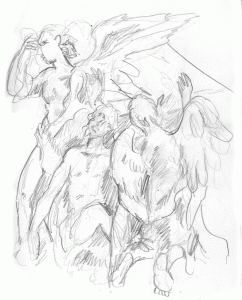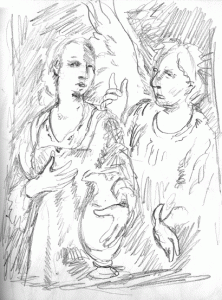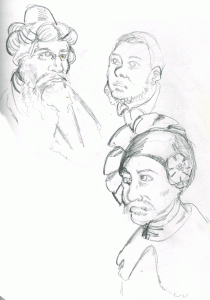Today we’re going on yet another take on Queen’s Bohemian Rhapsody. This one is a the Calculus Rhapsody By Phil Kirk & Mike Gospel and it replaces the original lyrics to a fun little math lesson. Enjoy
 Today’s sketch is yet another detail and angle of Lamentation of the Dead Christ by Massimiliano Soldani Benzi, previous sketches can be seen here and here. As I’ve mentioned before this is one of the pieces I keep coming back too since there is so much detail in it I can get a completely different drawing every single time. Even if I try to do the exact same angle.
Today’s sketch is yet another detail and angle of Lamentation of the Dead Christ by Massimiliano Soldani Benzi, previous sketches can be seen here and here. As I’ve mentioned before this is one of the pieces I keep coming back too since there is so much detail in it I can get a completely different drawing every single time. Even if I try to do the exact same angle.
This one is a bit of a mixed bag. As far as accuracy is concerned I kind of screwed the pooch. I fidgeted one too many times and ended up drawing at least three different angles at the same time and on top of that I don’t think I got the foreshortening on Christ’s leg’s quite right. Despite this I think I managed to pull it together and managed to do a halfway drawing even though it’s similarity to what I was looking at is lacking.
Let’s all with one one of his greats, the Saint Louis Blues.
 I went to Seattle Art Museum for their first free Thursday for the first time since I let my membership expire last year which means New Material!
I went to Seattle Art Museum for their first free Thursday for the first time since I let my membership expire last year which means New Material!
Today’s sketch is Hagar and the Angel by Bernardo Strozzi
A very nice example of chiaroscuro where the artist “creates a metaphorical wilderness out of nothing but darkness into which the arrival of the angel sheds bright light.”
Today’s Rhapsody is an Irish Rhapsody by Clare Grundman
 Today’s sketch is a group of details from the painting Christ Before Pilate by a “Painter from Cologne” It was done sometime in the 16th century in oil on wood and is an example of Antwerp Mannerism. I have to say this is one of my favorite works in the Seattle Art Museum’s permanent collection. I love the attention that the artist gives to the faces as well as the attention to detail
Today’s sketch is a group of details from the painting Christ Before Pilate by a “Painter from Cologne” It was done sometime in the 16th century in oil on wood and is an example of Antwerp Mannerism. I have to say this is one of my favorite works in the Seattle Art Museum’s permanent collection. I love the attention that the artist gives to the faces as well as the attention to detail l. In fact I initially started doing this sketch because I liked the “Roman” soldier’s helmet. Which brings me to why I really like this piece.
l. In fact I initially started doing this sketch because I liked the “Roman” soldier’s helmet. Which brings me to why I really like this piece.
Whatever my opinion of religion is, I like religious art. I think it’s how you can push the viewers buttons using an arsenal of symbolic vocabulary… What I really like about this piece is the way the artist does this painting as a 16th century period piece. If it wasn’t for the very familiar looking prisoner we would think it was just business as usual at a Hanseatic League meeting hall. Sometimes I wish that modern artists would keep doing this. Religious art these days is really bad most of it being these awful paint by numbers crap, personally I blame Reader’s Digest. They try to be “accurate” but in a way this makes it worse by drawing attention to all of the errors. After a while you have to ask yourself why bother? If Raphael was able to paint Roman Legionaries as conquistadors why can’t a modern artist put them into fatigues and flak jackets?






